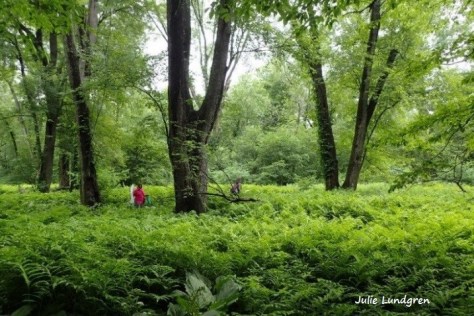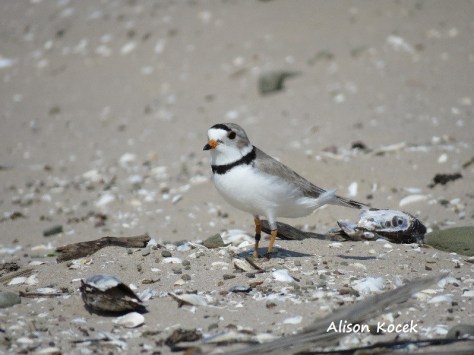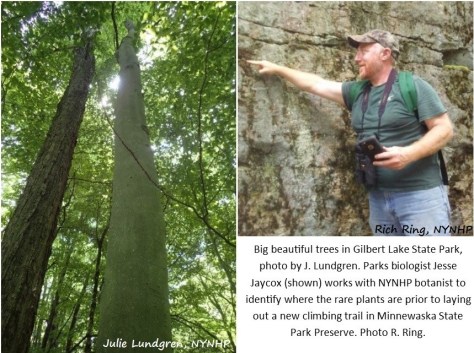Every year, the New York Natural Heritage Program (NYNHP) conducts field surveys in New York State Parks in search of rare plants and animals and high quality natural areas and features. There are always adventures as well as some surprises. Here a few highlights from 2018.

Bear Bath
We surveyed dozens of vernal pools in Parks this season as part of a statewide project to help identify pools that are critical for critters like fingernail clams, fairy shrimp, wood frogs, spotted salamanders and others. Just as we finished our vegetation sampling in a vernal pool in Minnewaska State Park Preserve, a huge black bear wandered in and sat down! So close. We watched quietly until it wandered off, then packed up our gear to head to the next site. What a great day!

The Joys of Sedge-ing
Keen eyesight and a skill for noticing subtle differences in the structure and color of plant parts is required to find rare plants. Sedges, a grass-like plant, are among the tougher species to identify. A trick is to looks for the triangular stems – “sedges have edges” – as opposed to round stems of rushes and grasses. From there, botanists use plant keys to figure out the identity.
Botanist Richard Ring and our summer botany assistant Ian Laih set out to to the hilltops in Franny Reese and Storm King State Parks in search of rare sedges. Success! They documented new locations in both parks for two rare and easily overlooked sedges; black-edged sedge (Carex nigromarginata) and Reznicek’s sedge (C. reznicekii).

A Flurry of Rare Dragonflies – Three in One Day!
The zoology team documented three species of rare dragonflies in one day at Harriman State Park: sable clubtail (Gomphus rogersi), arrowhead spiketails (Cordulegaster obliqua), and spatterdock darner (Rhionaeschna mutata)! The park’s forest habitat interlaced with streams, wetlands and ponds provides habitat for these cool critters.

Piping Plovers Return to NY’s Great Lake shoreline
State Parks and NY State Department of Environmental Conservation (DEC) stewards discovered a pair of nesting Piping Plovers at a park on the eastern shore of Lake Ontario and worked to keep them safe from pedestrians and dogs. Four chicks successfully hatched and entered the world. This is a really big deal, as the Great Lake plovers are federally endangered and the last successful fledging of chicks on NY lakeshores was in 1984! NYNHP had previously identified this area as among the best beach and dune habitats on Lake Ontario and has been working with State Parks to support protection of the rare species and habitats there. (Note you may be familiar with the piping plovers of the Atlantic coast which are listed as federally threatened).

Something Old and Something New
There are always many more places to survey and surprises to find. In the small Gilbert Lake State Park, while looking unsuccessfully for vernal pools, we were surprised to find a small patch of old-growth forest with large, over 120-year old ash, red oak, beech and maple. In Minnewaska State Park Preserve, NYNHP Botanist and Parks biologists surveyed the site of a proposed climbing route where a tiny rare fern, the mountain spleenwort (Asplenium montanum), was known. They confirmed and mapped an extensive population of the fern and also found a small but new location for the rare Appalachian sandwort (Mononeuria glabra). The new climbing routes can now be planned to avoid impacts to the rarities.

Fen Finds
Park’s Finger Lakes Environmental Field Team discovered a new location for a rare Rich Sloping Fen community and assisted NYNHP ecologist with vegetation sampling. Fens are a type of wetland fed by groundwater and that tend to be less acidic than bogs which are typically rain-water fed. They often support rare plant species too and sure enough, NYNHP ecologist spotted the leaves of the state-threatened marsh lousewort (Pedicularis lanceolata), a new record for this plant. Park staff returned to photograph and document it when it bloomed in August.

Salamandering
Allegany State Park in late June was the time to look for salamanders. Zoologist Ashley Ballou discovered a rare longtail salamander (Eurycea longicauda) near where they were last reported in 2009. This is a significant update of this almost 10-year old record. The park supports extensive and high-quality habitat for this and other more common amphibians like the red efts and red-backed salamander which we also saw during the surveys.

Going Buggy
We did a lot of work on insects! The Empire State Native Pollinator survey was highlighted in a previous state parks blog Counting the Bristlesides, Sedgesitters, Leafwalkers. There are still hundreds of specimens to be identified this winter, but some new rare insect species records have been confirmed already and there is such astounding diversity and beauty!
And thanks to expertise of others, we also obtained about 30 new records for rare moths in State Parks! Rare micro-lepidoptera (the smallest moths) were found in 8 state parks by Jason Dombroskie of Cornell University. And Hugh McGuinness finalized the results of a contract with us for moth surveys at two Long Island parks last year, adding a total of 20 records for rare moth species. All of this information goes into the NYNHP Rare Species Database.

Post by Julie Lundgren, NY Natural Heritage Program (NYNHP)
NY Natural Heritage Program is affiliated with SUNY College of Environmental Science and Forestry (SUNY ESF) and works in close partnership with NYS Parks and NYS DEC. NYNHP conducts many kinds of surveys and studies to provide guidance and tools for conservation of native biodiversity across New York State.
All photos by NYNHP for use by permission only.

